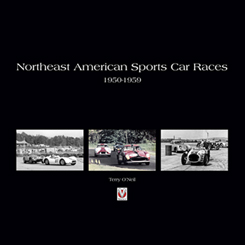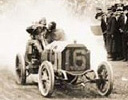Book Review
by Russell Jaslow
Northeast American Sports Car Races 1950-1959
by Terry O'Neil
Veloce Publishing
ISBN: 978-1-84584-254-3. List Price: $200.00.
  The first thing you notice about this book is the size. The over 400 pages. The weight not just from the size, but from the high quality paper and binding. The price. You immediately wonder, for the subject matter, is this overkill? The first thing you notice about this book is the size. The over 400 pages. The weight not just from the size, but from the high quality paper and binding. The price. You immediately wonder, for the subject matter, is this overkill?
After getting over the size, the next thing you notice is the author is from England, writing about racing in America. Local, regional racing in America. Local, regional sports car racing in America. Then, when you begin to read it, you notice the text uses the King's English. You immediately wonder, how informative can this book be?
When you read the book, you will discover these questions are answered, for the most part, satisfactorily.
Terry O'Neil is an accomplished author of books that required extensive research and is the Archivist for the Ferrari Owners Club of Great Britain. O'Neil's ability to research this book, even from England, is not an issue. He includes all sports car races in the northeast, even those whose details and/or results were impossible to find, whether they were sanctioned by the SCCA, AAA, USAC, MG Car Club, or the smaller local clubs that dotted the scene.
Most importantly, he doesn't bog us down with great detail for every race. This would turn a 400 page book into a 4,000 page book and cure insomnia forever. Instead, O'Neil does exactly what needs to be done -- a brief account of the important aspects of the races, mentioning only footnotes of the minor races, and getting a bit more detailed for the more important, significant, or exciting races. All this while writing in a style that is readable and doesn't put one to sleep.
It seems books on sports car racing all have to be big, heavy stock, expensive undertakings. Joel Finn's books are a perfect example. This is no exception. However, a key reason for this is to maintain the excellent quality of photographic reproduction. This is a plus with this book. The photos, some in color, do not lose anything on such high quality paper. Though some, understandably, have an amateur look to them -- after all, some were taken by family and friends by household cameras -- they add so much to the story and show scenes not captured by anyone else. I'm glad they were included alongside the professional pictures.
O'Neil picks this decade because major changes in sports car racing took place in those ten years. After the resurrection of road racing post World War II by Cameron Argetsinger at Watkins Glen, the sport went through a period of growing pains, trying to find its footing in the racing world, and the sports world in general, all the while navigating the internal political debates and the competition amongst sanctioning bodies.
Sports car racing went from the streets to airports to permanent circuits. It went from an amateur gentleman sport to factory supported efforts (sometimes concealed, sometimes out in the open) to professionalism. Some sanctioning bodies were very slow to recognize these changes. Some where not. Some teams and individuals welcomed these changes. Some did not. All of this taking place in the 50s would ultimately lay the path for sports car racing moving forward.
There were two areas of the country that prominently played a role in the direction of U.S. sports car racing in the 1950s -- California and the Northeast (with the Southeast, mainly Sebring, and the Midwest, mainly Elkhart Lake and Road America, also having an effect). O'Neil chose the Northeast to help tell this tale. However, he may have spent a bit too much time telling the story of the individual events and races instead of weaving them together to explain the overall development of the sport.
Unfortunately, this book will have a limited audience. The stars of the time (drivers, teams, and cars) weren't known outside of the sports car fraternity with a few exceptions. Thus, the book will lose the general racing fan who may have no trouble snatching up a book about 1950s Indy car or Formula 1. And, even for those who do know sports car racing from that era, the book may only attract those who know the players from the Northeast.
Nonetheless, for those who lived it or heard stories about the events depicted in the book or who have an interest to learn about what essentially was grassroots racing for most, it will fill that need, albeit at a hefty price tag.
The result pages could have been presented with a better layout, eliminating a lot of white space and empty box scores (without sacrificing the need to communicate the areas the author could not fill in) and in doing so save a number of pages.
As for the King's English, well this may be more of a pet peeve of mine. If you are going to write a book on an American topic, and more importantly, if Americans are going to make up 99% of the buyers for the book (most likely in this case), then as a Canadian friend once told me, you need to de-U-nify the transcript.
Copyright © 2010 by . All Rights Reserved.
|



